Becky Shindell The Ultimate Facebook Ads Audit Guide #semrushchat 63 Wow-Score The Wow-Score shows how engaging a blog post is. It is calculated based on the correlation between users’ active reading time, their scrolling speed and the article’s length. Learn more The Ultimate Facebook Ads Audit Guide #semrushchat
- 171
- 33
- 22
- 38
- 2
According to a study by Mediakix, people spend an average of 35 minutes a day using Facebook, and, as of June 2017, Facebook has said that they boast over 2 billion monthly active Facebook users. So, what exactly does this mean for marketers? Facebook represents a huge potential market for social media efforts and is a great place to advertise.
To reach maximum efficiency with your Facebook Ads campaigns, it is not enough to track the number of likes and shares. By carefully analyzing your campaign results you can better figure out what works and what doesn’t. A smart Facebook Ads audit will help you to discover the potential problems and improve your advertising strategy. To help you identify opportunities to boost your Facebook Ads performance, we invited Dennis Yu, Chief Technology Officer of BlitzMetrics and contributor to Adweek, Social Media Examiner, 3Q Digital and more, to our SEMrush Chat.
To begin with, we asked our chat participants how often they recommend running Facebook Ads audits.
Q1. How often do you suggest auditing your Facebook Ads?
According to our guests’ answers, the most popular option is on a daily or weekly basis. Monitoring your Facebook Ads campaigns daily allows you to quickly understand what works for you and adjust your strategies accordingly. On the other hand, daily monitoring can be useful during the first stages of your campaigns. As some of our chat participants believe, when everything is well set, a few times a week can be enough.
A1 We like to look at ad performance daily so we can make any necessary adjustments #semrushchat
— PolePositionMkg (@PolePositionMkg) August 2, 2017
A1. Daily monitoring and refinement is the best practice initially, but then it can be a few times a week #semrushchat
— Craig Campbell (@craigcampbell03) August 2, 2017
Your choice of how often to audit your ads also depends on your campaign goals and your budget. Each of your campaigns should have a clear goal that applies to your overall marketing objective. If you are a small business that is looking to increase the number of email subscribers, your budget may differ from a budget of a business that’s promoting a sale. Accordingly, the frequency of monitoring your Facebook campaigns may also differ.
A1: Depends on your budget/goals of the ad campaign. Could be daily/weekly/bi daily #semrushchat
— Devin (@DevDawg) August 2, 2017
A1: It depends on the goals of the account and the budget. $500/mo for just branding will not get audited daily. #semrushchat
— Steve Seeley (@SteveSeeley) August 2, 2017
Zack Bedingfield – @zackbedingfield pointed out that if you have enough data to work with, you can monitor your ads as often as you need to. To collect more information about your audience, you can use Facebook Audience Insights, which is an intelligence tool that enables you to uncover your audience’s demographic and behavioral data.
A1: It depends on how much data you have. If your audience is small, it may be awhile before you can make educated decisions. #semrushchat
— Geena Nazareth (@GeenaNazareth) August 2, 2017
Finally, our special guest believes that a 15-minute optimization cycle is a good option.
A1) 15 minutes a day. Since it's about small iterations along the way https://t.co/WI6E3M3dDH #semrushchat
— Dennis Yu (@dennisyu) August 2, 2017
To find out more, you can check out his guide: “How I Optimize Facebook Ad Campaigns In 15 Minutes Per Day.”
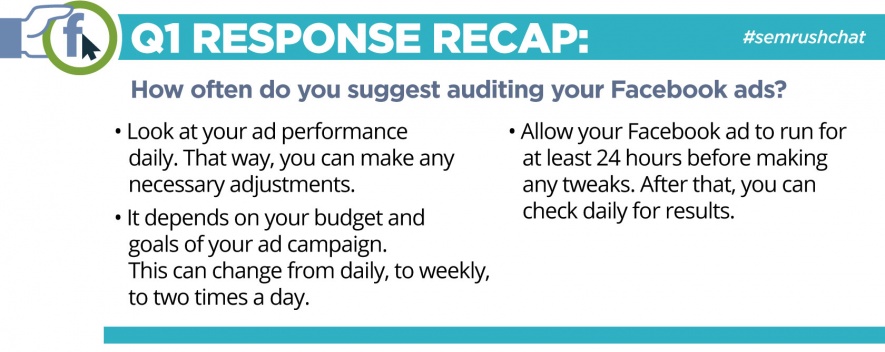
A Facebook Ads audit is an evaluation of your marketing efforts. It enables you to keep your campaigns optimized and change and improve them, when necessary.
Q2. In your opinion, what are some examples of metrics of a successful Facebook Ad?
Once you run an advertising campaign, it is important to understand how to evaluate its performance.
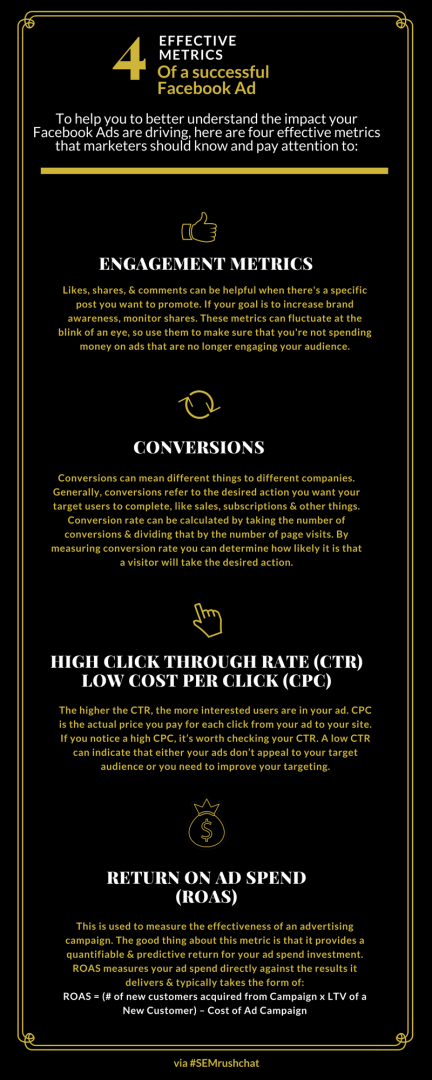
Specials thanks to everyone whose tweets we used to make this image: @dennisyu, @DevDawg, @RE_Wertheimer , @DigitalVK, and @bright_local!
Determining the proper metrics to evaluate your advertising campaign allows you to optimize your Facebook Ads strategy appropriately to improve ads performance.
Q3. Video vs. Image Ads — which one works better?
Advertisers are always looking for new and creative ways to promote their products and services. As more companies start using Facebook Ads as part of their digital marketing strategy, the platform is becoming a more competitive landscape. Therefore, standing out from the crowd isn’t always easy.
If done right, both images and videos can be a great way to connect with your audience. But which will produce better results? We decided to ask our chat guests:
The opinions are divided. Roslyn Wertheimer – @RE_Wertheimer believes that there is an excessive number of video ads and a good image is what can really help you get creative with your ads.
A3 I think there are just too many video ads out there. Image ads stand out, even if FB doesn't push them as much as video #semrushchat
— Roslyn Wertheimer 📸 (@RE_Wertheimer) August 2, 2017
Images remain one of the most popular types of rich media advertising on Facebook. To make your campaign more effective, you need to pay attention to what appeals to your target audience most and adjust your images based on your users’ needs and wants.
On the other hand, some of our chat participants think that video ads are the most powerful Facebook ad format. Great videos help you to effectively generate user engagement because they offer more engaging content than static posts do.
A3: Videos, without a doubt.
Reason: It engages the user far more… #semrushchat— Saad AK (@SaadAlikhan1994) August 2, 2017
A3: Personally haven't run video, but I hear it works fantastic #semrushchat
— Rachel Howe (@R8chel_Marie) August 2, 2017
When choosing between an image and video format, think about the demographics of your users. Different ad formats can better appeal to different audiences. Learn more about your potential customers to understand what will resonate with them most.
A3) Depends on where the adverts are viewed as well as the demographic of the viewers #semrushchat
— Paul Gregory (@chimpfish) August 2, 2017
When it comes to ad formats, the Kula Partners – @kulapartners team pointed out the importance of your ad campaign goals; if you want to explain to people how to use your product or service, consider using a video format. Videos are an especially compelling way to learn how to do something online. According to a survey by Animoto, 4 times as many customers would prefer to watch a video about a product, rather than read about it.
In case you want to share some fresh statistics and interesting facts with your audience, you can create a stunning infographic to effectively attract their attention.
A3: Depends. Are you explaining how to use a product? Video. Are you providing stats and product facts? Infograph. #semrushchat
— Kula Partners (@kulapartners) August 2, 2017
Our special guest recommended investing your efforts in creating videos, except for the cases when you run a conversion-focused Facebook Ads campaign:
A3) Video nearly always, except for conversion ads. Create a 3×3 video grid like this: https://t.co/cAmyompX8X #semrushchat
— Dennis Yu (@dennisyu) August 2, 2017
Steve Seeley – @SteveSeeley reminded us of one more ad format—carousels, which allow you to show up to ten images or videos in a single ad. With carousels, you can highlight your multiple products or demonstrate specific details and qualities of your single product.
A3: Carousel ads for ecom and even service related campaigns work great. Comes down to your targeting though. 🙂 #semrushchat
— Steve Seeley (@SteveSeeley) August 2, 2017
To better understand what may work best for your business, you can experiment with different ad formats and test different options. “Test a combo of a single image, video, and carousel to see what converts,” said Dennis Yu – @dennisyu. This will help you determine what resonates with your audience best and then you can craft your Facebook Ads accordingly to deliver better results and get the maximum ROI.
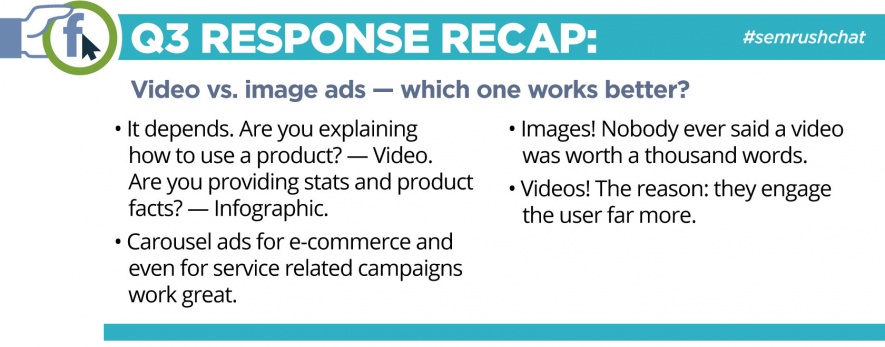
Q4. How do you check what your competitors are doing on Facebook and which audiences they’re targeting?
When it comes to competition, any business wants to know what their rivals are doing, what they are using, and how successful their activities are. If you want to know your competitors’ Facebook Ads strategies and which audiences they are targeting, try out these simple, yet still effective tactics:
1. Use AdEspresso.
AdEspresso has a vast library of Facebook Ads from brands across the globe. It shows ads searchable by keywords, industries, goals, placements, and attributes. You can check out Facebook Ads from various businesses, including your competitors. Once you know what other advertisers are doing, you can use this inspiration and find opportunities for something new and unique to build your ads that can appeal to your audience.
A4: i use @AdEspresso and also "why am i seeing this ad?"option on competitor fb ads #semrushchat https://t.co/Nu4Ophx0VJ
— Ramakrishnan (@RamkiJeyam) August 2, 2017
2. Click the Prompt Asking "Why am I seeing this?"
In 2014, Facebook introduced a new feature that enabled users to discover why a specific company was showing them particular ads. You have probably noticed a little button “Why am I seeing this?” on ads that appear on your newsfeed. By clicking it, you can get access to some spy-worthy data on how and who the company is targeting with their ads. This can also include information about the key variables, like age, location, and interests.
Dennis Yu – @dennisyu suggested visiting the company’s website to be retargeted. In addition to that, you can also sign up for their newsletters and spend more time on their webpages to make sure that more of their ads will be sent to your Newsfeed, so you can get more information about their advertising campaigns.
Q4) you can click in the top right of ads to see what they're targeting. Visit site to be retargeted. #mosquitos #semrushchat
— Dennis Yu (@dennisyu) August 2, 2017
3. Analyze Your Competitors’ Content Engagement
Spying on your rivals’ content and engagement rate will provide you with more insights into your competition. Sponsored posts that are promoted through Facebook Ads will usually have higher reach and engagement. You can compare the high-engagement post to the typical post on the company’s timeline to see if high engagement is organic or if they earned it due to advertising. Engagement metrics, like shares, likes, and comments, show how successful your competitors’ social presence is. In addition to AdEspresso, there are other Facebook Ads galleries as well.
4. Use Your Audience As a Source of Information
The fans of your competitor’s Facebook fan page have the same interests as your target audience. It means that you can find out who your competitors are by researching your own audience who is likely to fall into the same demographic group that your competitors are targeting. Look at who your audience is following on Facebook and learn more about brands that are similar to yours.
A4) Ask your audience. They almost certainly fall into the same demographic(s) that your competitors will be targeting #semrushchat
— Paul Gregory (@chimpfish) August 2, 2017
Let’s sum up!
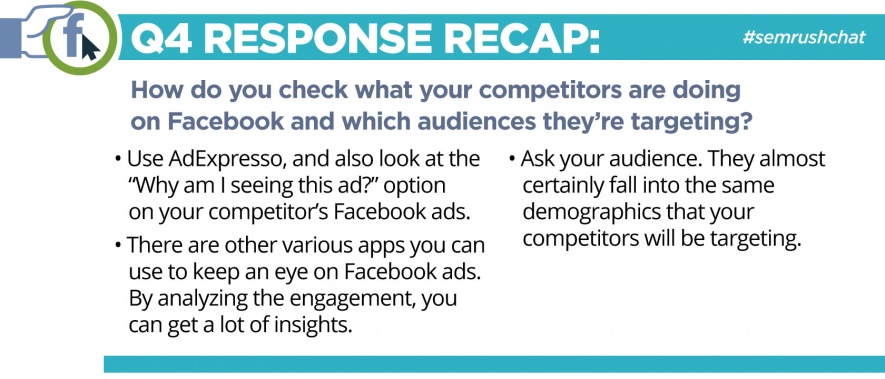
As you can see, spying on your competitors’ ads is not so hard. By learning about their strengths, their value propositions, and things they pitch to their users, you can find weak points in the strategies that you can exploit with more effective targeting and a better pitch.
Q5. When A/B testing Facebook Ads, is it more effective to use separate campaigns or to use multiple creatives in the same campaign?
A/B testing is an easy, yet effective way to compare different versions of an ad to determine which one provides the best results related to your marketing objectives. A/B testing helps advertisers figure out which ad headlines, images, copies, and calls-to-action work best on their target audience.
When it comes to Facebook Ads A/B testing, you can use either separate campaigns or multiple ad creatives in the same campaign. As we noticed during our discussion, most of our chat guests prefer to create different ad creatives and ad sets in one campaign. Ramakrishnan – @RamkiJeyam explains that this approach gives him more insights into the audience behavior.
A5: A true A/B test would be in same campaign. If parameters are more different to require diff campaigns, not really A/B.#semrushchat
— Julie F Bacchini (@NeptuneMoon) August 2, 2017
A5: I always find my self creating 1 campaign with different ad sets and different creatives per ad set. #semrushchat
— Danny Ray Lima (@dannyraylima) August 2, 2017
A5. Different ad creatives: Pre-gaming millinials with culture/interest driven content vs. parent content for older gens #semrushchat pic.twitter.com/6ZXa5zrHg0
— TWO MEN Marietta (@TMT_Marietta) August 2, 2017
On the other hand, some advertisers find it useful to exploit both tactics:
A5 Never hurts to use both tactics. But I do think different creatives gives audience other perspectives of the campaign. #semrushchat https://t.co/ofLUcWsuF7
— Scylla Lopez (@ScyllaLopez) August 2, 2017
A5: I do both as some campaigns may have different targeting criteria. #semrushchat
— Steve Seeley (@SteveSeeley) August 2, 2017
In fact, there are various aspects that can influence which approach will be the most effective. Overall, there are several things to keep in mind:
-
It is applicable to test different ad creatives in the same campaign.
-
You can try out different ad optimization approaches, depending on several aspects, such as the funnel stage and your budget. Massimo Chieruzzi, the CEO and Founder of AdEspresso, explains that even though he is not a big fan of A/B testing across multiple campaigns, it may still be useful when you are testing extremely different variations (i.e. the bidding type or the type of ad).
A5) Depends on funnel stage. For top and mid-funnel, boost posts. For conversion or evergreen triggers, yes on many combos. #semrushchat
— Dennis Yu (@dennisyu) August 2, 2017
A5. #SEMRushChat Depending on your budget, I think it's best to do A/B so all conditions are the same. (Time, weather, whatever) pic.twitter.com/o7AyHvLyp3
— Colt SebastianTaylor (@ColtSTaylor) August 2, 2017
It is important to note that there may not be a single method that works better than the others in all cases and you should adapt your approach according to your needs and goals. However, there is no doubt that A/B testing is one of the most effective ways to optimize and improve your ads.
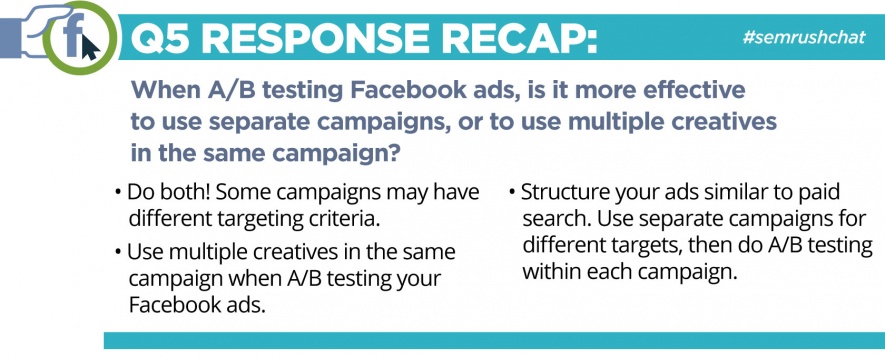
Do you use separate campaigns or prefer to test different ad creatives in the same campaign? Don’t hesitate to share your experience and your questions in the comments!
Q6. Budgeting: How do you plan your budget and how do you know when to add more?
Regardless of how much you spend on advertising, you need to spend your money well. Therefore, before launching a Facebook Ads campaign, you need to develop a solid budget plan. Our chat participants shed light on how they plan their advertising budget:
1. Plan Your Budget Based On Your Audience Size
In his guide “How Much Do Facebook Ads Cost? A Budgeting Guide for Small Businesses,” Dennis Yu – @dennisyu explains that your Facebook is a remarketing engine. If you are already driving conversions via SEO, email marketing, AdWords, or other channels, this social network can bring you more visibility, leads, and sales, if done right. It gives you another opportunity to deliver your message to your audience. Budgeting should be based on how big your remarketing audiences are. “That means for every 100 people that have clicked on an email of yours, for every 100 people that have come to your website, you will retarget them on Facebook,” says Dennis.
A6) budget by audience size and performance in THIS way: https://t.co/IthPy924gb semrushchat
— Dennis Yu (@dennisyu) August 2, 2017
2. Start Small
If you are planning to launch your first Facebook Ads campaign, there is no need to invest a large sum of money from the very beginning, especially if you don’t have the massive media budgets that global enterprises spend on advertising. If you are a small business, with a limited digital ad budget, Facebook is a great place to increase your advertising efficiency. Compared to search engines ads, Facebook Ads have a lower CPC. According to Brian Carter’s findings posted on Moz, if you spend $1 on Facebook Ads per daily you can grow your audience by 4,000 people.
A6: Don't be afraid to start small when it comes to your budget. You can increase once you know your ad is effective. #semrushchat
— Express Writers (@ExpWriters) August 2, 2017
A6 Best to start with a small budget. You can spend more or less as you see results. #semrushchat https://t.co/MEZHYPFKAv
— Scylla Lopez (@ScyllaLopez) August 2, 2017
Remember, you can always add to your budget, if you see positive results:
A6) Start small. Find where the payback is. Increase spend in line with conversions and ROI #semrushchat
— David Rosam (@davidrosam) August 2, 2017
3. Keep Your Marketing Goals in Mind
When launching your ad campaign and planning your budget, think about why you want to advertise on Facebook. Is it for brand awareness, product placement, or some special event that is coming up? Based on your goal, you then can decide which action you want your target users to take after seeing your ad: website clicks, page likes, lead form submissions, or other actions. This will allow you to allocate your budget more effectively.
A6: I align my budget w/what I can afford. For clients, estimate ur budget based on your goals & calculate based on estimates #semrushchat
— Rachel Howe (@R8chel_Marie) August 2, 2017
4. Use Customer Lifetime Value
Customer lifetime value (CLV) is an important metric that can help advertisers optimize their advertising spending. In marketing, CLV means a prediction of all the value a company will derive from their entire future relationships with a customer. To put it simply, you are taking the revenue generated from a client, subtracting the money spent on sales, marketing, and other areas, and then adjusting it for the duration of your relationship with them. This metric allows you to determine how much you should spend on customer acquisition and retention.
A6: If it's to increase leads or sales, I'll take into account; service or product cost and life time value cost of customer. #semrushchat
— Danny Ray Lima (@dannyraylima) August 2, 2017
As you can see, it is not as difficult as it may seem! Use these tips from our chat participants to effectively optimize your advertising strategy.
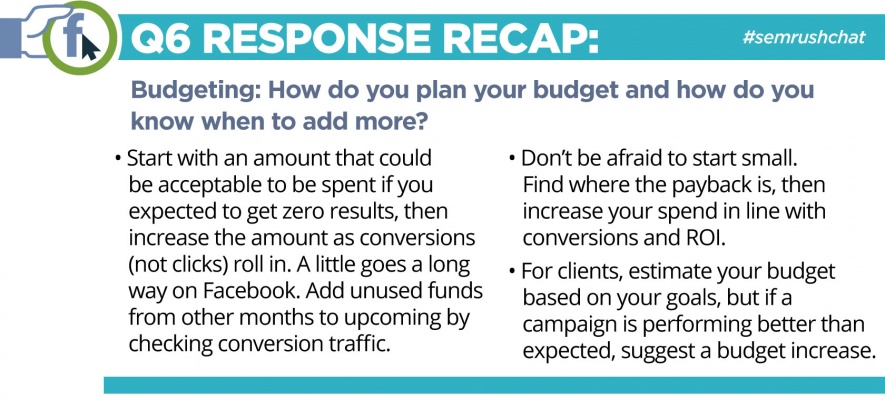
There are so many things to learn about the ever-changing and improving possibilities of advertising with Facebook. Hopefully, the tips from this post will help you become a master of Facebook marketing!
We would like to thank Dennis Yu and our other chat guests who helped us to make this discussion interesting and productive.
The Ultimate Facebook Ads Audit Guide from SEMrush
Make sure to join us this Wednesday as we discuss “The State of SEO in 2017” with Kevin_Indig!
Social MediaRead the original article here



